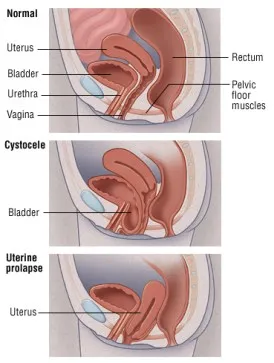Introduction
In this post I will be talking about the uterine prolapse /prolapse of the uterus,its symptoms treatment with both Medical / Surgical and Physical Therapy.
It is a common condition in women, statistically it is said that nearly half of the women b/w age 50 to 79 have some degree of uterine prolapse.This is not medically dangerous or an emergency condition.People can engage in sexual activity following the diagnosis of prolapse , intercourse may feel uncomfortable.
Anatomy :

The uterus is located in the pelvis supported by ligaments and pelvic floor muscles which form a hammock .When one or both the pelvic floor muscles and ligaments get weak the organs are no longer are held up in place and may sag to be out of place through the vagina.
Causes
Damage to the supporting structures of uterus can occur:
- During Childbirth ( usually the most significant cause )
- Chronic constipation
- Chronic coughing
- Genetically weak connective tissue
- Aging process.
- More causes from my previous post

Diagnosis and Degree of Prolapse:
The degree of prolapse depends upon how far down the vagina the protrusion of uterus has occurred.Your Dr. will determine the degree of prolapse on pelvic exam. If you have symptoms of incomplete bladder emptying the Dr made do a Cystoscopy to look inside the bladder.
MRI may also be done to accurately assess the internal organs.
Uterine Prolapse and Infertility
Uterine prolapse can reduce the chance of a couple getting pregnant since the uterus is not positioned properly to receive and keep the sperm alive.Sperm dies when exposed to air.This can be corrected surgically by hysteropexy.

Uterus Prolapse and Pregnancy
Women with mild to moderate prolapse can get pregnancy .During the pregnancy progression of the prolapse can be minimized by adapting the lifestyle modifications mentioned below. Learning to relax the pelvic floor is very important to all for a smooth vaginal birth and not further increase the prolapse.Pelvic floor relaxation can be done through diaphragmatic breathing .Recommended to discuss with Dr. regarding the type of birth Vaginal vs C section keeping the prolapse in mind.
Uterus Prolapse and Running
Running is high impact activity which can put a lot of stain on a pelvic floor and the uterine prolapse has a potential of getting worse with running Somethings that can be done to prevent the prolapse from getting worse are as follows .
- Decrease the speed of running
- Decrease the running distance. Long distance running put prolonged pressure on the pelvic floor.
- Run on a level surface , avoid running on concrete.
- Avoid running uphill. The posture of leaning forward as one goes uphill can increase the intra abdominal pressure and in turn affect the pelvic floor.

Symptoms specific to Uterine Prolapse: It time to see a Dr, when you experience these symptoms
- Heaviness or pulling feeling/pain in the vagina .My patient generally describes their symptoms as “I feel like something is falling out of my vagina.”
- Progressively increased heaviness in the vagina as the day progresses.When the prolapse is of an advanced degree a pink bulge can be noticed at the vaginal entrance (with use of a mirror to look ), in standing or with coughing and straining.
- Pain with sexual intercourse
- Urine leakage during sex.
- Difficulty or inability to have an orgasm.
- Stress ( with coughing, sneezing and laughing ) urinary incontinence.
- Difficulty with bowel movement
- Patients may have to use the finger through the vagina to help empty the bladder or have a bowel movement.
Treatment :
Lifestyle Modifications:Control what you are able to control .
- Proper Biomechanics of lifting/pushing or pulling : Do not hold your breath , but exhale with exertion and lift from the legs and not your back.
- Sitting posture .Avoid slouching when sitting on a couch or at the desk working ,to decrease the pressure put on the pelvic floor.
- Standing posture.Try to maintain a neutral spine to avoid slouching, this does not have the core muscles firing effectively and the pelvic floor and core muscles need to be working together in sync.
- Wt.management
Most prolapses once they become symptomatic need some degree of intervention.
Mild to Moderate degrees of prolapse can be treated and some cases reversed with Physical therapy with Kegel exercises.This can adequately strengthen your muscles to prevent further progression of the prolapse.
Severe Degrees of prolapse will still benefit from skilled PT as a preoperative intervention to strengthen the muscles as I always tell my patient’s “You go into surgery stronger you come out stronger and the recovery is faster.”Once the prolapse is of a severe degree it will need surgery since that will continue to get worse .

Surgical Repair of prolapse – Vaginal Hysterectomy
Vgainal Hysterectomy is the common surgery done to address Uterine Prolapse.This is a procedure where the Uterus is removed via the vagina.This method has better recovery and has no abdominal or laparoscopic incisions.
The surgery is performed in a hospital setting under general or spinal anesthesia.
The surgeon makes an incision around the cervix, the bladder and rectum are carefully moved and all the major blood vessels clamped and then the uterus is removed and the top of the vagina is sutured and this is called the vaginal vault.
Success rate after Surgery
85 % of women who have a Vaginal Hysterectomy are cured of uterine prolapse.About 15% may develop a vaginal vault prolapse in the months or years later.

Complications of Surgery:
As with any surgery there are some possible complications.
- Infection , Surgical site ,or urinary tract infection.
- Blood clots
- Urinary retention
-
Injury to any of the adjacent organs during surgery
Recovery after Surgery
Patients are usually recommended to “take it easy ” for about 6 weeks and avoid any heavy lifting.Sexual activity may be resumed after discussion with Dr. after 6 weeks.

Conclusion
- Treatment of uterine prolapse depends on the degree of prolapse
- Pelvic PT and lifestyle modification is an effective way to manage mild to moderate prolapse
- Surgical option for the advanced stages of prolapse.

References
Pelvic Floor Function,Dysfunction and Treatment( Level 1) Herman and Wallace
